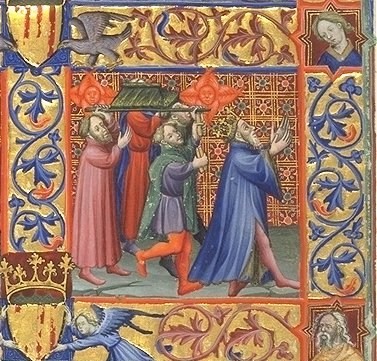
King David Dancing Before the Ark, 15th century
Lecture 8. November 25, 1947
David and Solomon represent the focalizing of the symbolism of the king, the consolidation of religious and secular authority. These men are important not so much as rulers as for the consolidating of religion. David captures Jerusalem, the focus of political and religious aspiration. But it is the same centralizing of something far more primitive. It shows up in the Middle Ages in the person of the consolidating figure of the priest-king, the head of religion and state,
Samuel II, Chap. 6: David brings the ark to Jerusalem, the City of David. Before Jerusalem was taken and the temple was established, the Israelites had a wandering temple, the Ark of God. This Ark would be the thing that represents the protection of the Israelites by God. When the Philistines captured the Ark of God, the Israelites knew they were licked. Then they got it back. A temple is built for the Ark. The return of the Ark is told in Samuel, in which it is regarded as a sacred thing, as a reservoir of electric force. David leads the dancing procession (verses 20-22).
The king who leads the service is also exposed to humiliation. David is willing to accept this as part of kingship. Verses 18-19: the entry of the Ark is signalled by a communion feast distributed by the king. This is repeated in the feeding of the 5000, which is the prelude to the communion feast itself. The conception of communion is still there. True honour comes from the act of suffering and humiliation. David is intimate with God, the chosen Son of God. It doesn’t make him divine, though. Psalm 45 shows the symbol of the king.
The city and the temple are seen as the only place were religion is. God is only there. The distinction between city and temple is dissolved until there is no distinction. The king represents the people in a single human form as the elected Son of God. David is the Son of God and, at the same time, all the Israelites are in the body of David.
The Songs of Solomon show the king in a real sense as the fertility of the land. They have three meanings:
1. A love song between two people of whom the man becomes Solomon; the male represents the king;
2. The marriage of sun and earth, the awakening of fertility. Chap. 4: the king speaks. The woman is the land that comes awake with spring; she is black because she is the fruitful soil. The male is Solomon who is all the people in one form; the woman becomes the man;
3. An allegory of the love of Christ for his Church.
Zechariah himself describes the rebuilding of the temple. Verse 16 shows that the fertility of the land is bound up with observance of the cult. This marks the passing of the farmers’ religion into the nomadic Israelite cult. But with the king as the male and the land as the female, this allegory holds only as long as you believe in sympathetic magic. All magic is founded on the fact that you can bring out an effect by imitating it.
The Israelites outgrew that stage. They realize that God sends rain on the just and unjust alike. They see that the laws of nature cannot be run that way. This involves a shift of symbolism. First you have the king and the people as one body (male) and the land as female. This shifts to God as the male principle and the people and the land as female. The people and the land are subordinate to God who is the real or active principle. The king and the people do not produce the fertility; God does.
In the prophets, it is the people of Israel who are the bride, the faithful. The unfaithful is the harlot. In Christianity, God is Christ. Later on, the people are not associated with the land anymore; they are the church; the body of God’s church are the people.
Among the prophets, you get Amos in the Northern Kingdom in the 8th century, then Hosea, first Isaiah, Micah. This is the first of many attempts to reform the pre-prophetic religion, the law of God. They want to reform the cult. This teaching continues to the fall of Jerusalem and Jeremiah. In the 8th century they prophesied before the fall of the Northern Kingdom. When Jerusalem fell, then the pre-exilic prophecy ended. In the exilic period comes the hope of rebuilding, in Ezekiel and Isaiah II. This is followed by the post-exilic prophets.
